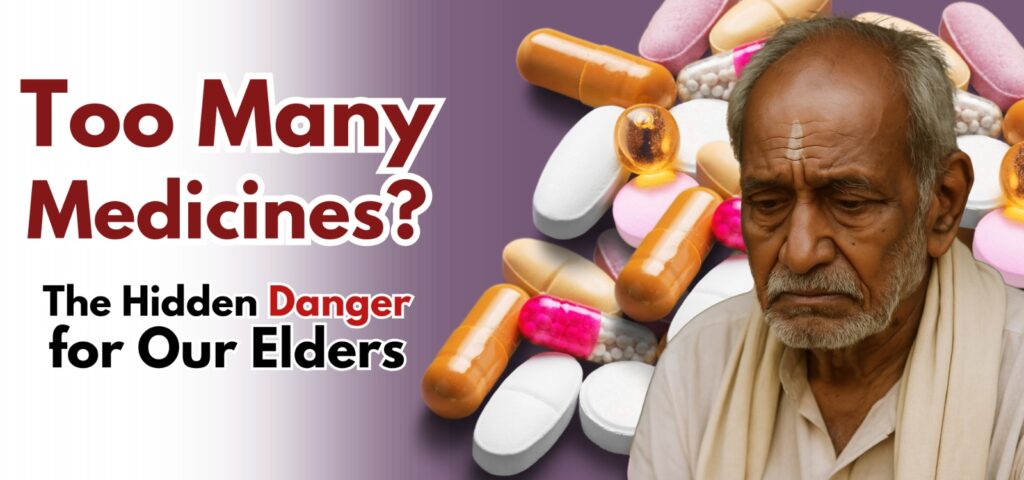As our global population ages, a silent yet potent threat has emerged in the realm of eldercare: too many medicines. Commonly known as polypharmacy, this condition involves the use of five or more medications by a single patient and is increasingly prevalent among older adults. While modern medicine has extended life expectancy, it has also inadvertently created a new public health crisis—one that compromises the quality of life for our elders.
Elderly individuals often juggle numerous medications for chronic conditions like diabetes, hypertension, arthritis, and heart disease. However, the intersection of multiple medications, reduced physiological resilience, and cognitive decline leads to a dangerous cocktail that heightens the risk of adverse drug reactions, hospitalizations, and even premature death.
The book Health and Wellbeing in Late Life by Dr. Prasun Chatterjee provides a holistic and narrative-based approach to understanding ageing in India. Drawing from this invaluable resource, this blog explores how polypharmacy, often driven by uncoordinated care and social ignorance, is silently harming our elders—and what we can do about it.
The Hidden Danger: Too Many Medicines
A. Understanding Polypharmacy in Elders
a. Definition and Scope
Polypharmacy refers to the simultaneous use of multiple medications, often without proper coordination among healthcare providers. While not inherently harmful, the issue arises when medications interact negatively, are unnecessary, or cause side effects that outweigh their benefits.
b. Reasons It Happens
- Consulting multiple specialists independently
- Lack of a central care coordinator or geriatrician
- Treating symptoms instead of holistic conditions
- Absence of patient or caregiver medical literacy
Dr. Chatterjee recounts in his book that many elderly patients see different specialists for various ailments. A patient may see a cardiologist for hypertension, a diabetologist for sugar, and an orthopaedic for joint pain—each prescribing drugs without considering the other treatments.
B. The Risks of Too Many Medicines
a. Physical Consequences
- Adverse Drug Reactions (ADRs): Older adults are more prone due to altered drug metabolism and organ sensitivity.
- Falls and Frailty: Some medications lead to dizziness or confusion, increasing the risk of falls—a major cause of disability.
- Hospitalizations: Studies show that over one-third of elderly hospital admissions are drug-related.
b. Psychological Impact
- Cognitive fog, memory lapses, and emotional disturbances are commonly linked to drug interactions or side effects.
- Older patients, like Mr. Tripathy in the book, report feelings of fatigue and weakness that aren’t linked to any one disease but are worsened by excessive medication.
c. Financial Strain
- Medications form a large part of monthly eldercare expenses.
- In India, as highlighted by Dr. Chatterjee, over 65% of elders are financially dependent, making polypharmacy not just a medical issue but an economic one.
C. Systemic Causes and Gaps
a. Unprepared Health Systems
India has fewer than 100 trained geriatricians to serve over 120 million elders. The concept of holistic geriatric care is still emerging.
b. Social Unawareness
Even well-educated families fail to recognize functional decline and assume multiple prescriptions mean better care. In contrast, underprivileged families often accept symptoms like fatigue or pain as “natural ageing”.
c. Absence of Active Ageing Philosophy
A focus on treating diseases, rather than preventing decline, leads to reactive overmedication. Mr. Tripathy’s case showed how proactive lifestyle measures like nutrition and exercise helped reverse pre-frailty without medications.
D. Real-Life Narratives from the Book
a. Mr. Mukherjee’s Story
A retired civil servant, Mr. Mukherjee was on numerous drugs for diabetes, hypertension, and insomnia but lacked knowledge on vaccinations, diet, and preventive ageing. Despite access to quality care, he was unprepared and unaware—common in even elite circles.
b. Mrs. Bajaj’s Decline
Her condition deteriorated due to infections aggravated by frailty and polypharmacy. Her story is a chilling reminder of the need for holistic care and family support in elder health management.
E. The Way Forward
a. Conduct Regular Medication Reviews
Geriatricians should periodically reassess the necessity of each drug. Unnecessary medications should be deprescribed.
b. Promote Active Ageing
Encourage physical therapy, diet modification, and meaningful engagement to reduce dependence on drugs.
c. Establish Central Care Coordinators
Assign a family member or physician to supervise and unify treatment plans across different specialties.
d. Build Awareness and Education
Families and caregivers must be educated about functional health and the risks of overmedication.
e. Policy-Level Reforms
Universal Health Coverage and inclusion of geriatric pharmacology in medical education are crucial. The book advocates for a multidisciplinary public health model with trained professionals at primary health centres.
Conclusion
Polypharmacy is not merely a byproduct of modern medicine—it is a symptom of systemic gaps, unpreparedness, and fragmented care. Elders deserve more than a shelf full of pills; they deserve a life of dignity, comfort, and autonomy.
By embracing a holistic approach grounded in active ageing, intergenerational solidarity, and coordinated care, we can combat the hidden dangers of polypharmacy. Dr. Chatterjee’s work offers a blueprint rooted in real experiences, one that can help shape a better, more compassionate healthcare future.
Let us reframe eldercare: from reactive to proactive, from fragmented to integrated, and from medicine-heavy to wellness-focused.

